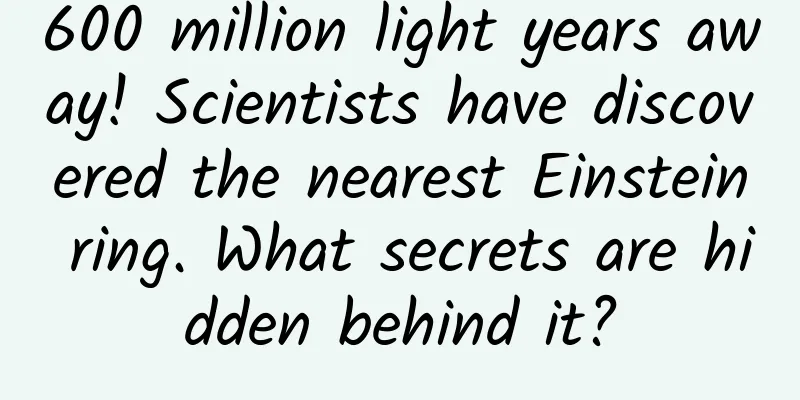[Creative Incubation Program] Is the plot of "Jurassic World" realistic? Can we resurrect dinosaurs?
![[Creative Incubation Program] Is the plot of "Jurassic World" realistic? Can we resurrect dinosaurs?](/upload/images/67f26030af88c.webp)
|
Author: Liu Sen Recently, Jurassic World 3 was released, which caused a wave of movie watching. As a dinosaur fan, we are all more or less curious about one question, that is, can we revive dinosaurs like in the movie? Can we? Let me tell you slowly. In the world of the Jurassic series of movies, resurrecting dinosaurs relies on extracting dinosaur DNA from the stomachs of mosquitoes that have sucked dinosaur blood and are preserved in amber, then supplementing the incomplete fragments with genes from other modern species, and then using cloning technology to resurrect the dinosaurs. Is this possible? First, we need to understand whether it is possible to extract dinosaur blood from the stomachs of mosquitoes. Now, here is an amber fossil found in Myanmar, which dates back to the Cretaceous period about 100 million years ago, when dinosaurs lived. Although there is no mosquito wrapped in it, there is a roundworm that also feeds on blood. So can we get dinosaur DNA by extracting blood from the stomach of a dermestid? The answer is no, because these insects have been petrified and do not retain any organic matter in their bodies, let alone the blood in their stomachs. The reason for this phenomenon lies in the process of amber formation. The resin drips and wraps the insects, and then they are buried underground. After a long period of high temperature and high pressure, amber fossils are finally formed. In this process, some minerals will penetrate into the amber through the cracks on the surface of the amber along with water and other solutions, and completely replace the organic matter of the animals and plants wrapped inside. This process is like pickling salted duck eggs. Although the outer skin of the duck eggs is intact, the salt will still penetrate in with the water, making the egg liquid inside salty. Scientists in our country have done research in this area. They sliced some amber wrapped with insects and found that the bodies of the insects inside were completely filled with calcite and silica into fossils. Therefore, it is impossible to extract dinosaur blood from mosquitoes as in the movies. Using the dinosaur blood in the mosquito's stomach is a dead end. But what if we found a dinosaur preserved in amber? I think people who hear this idea will find it very ridiculous. Dinosaurs are so big that it is impossible to put them in amber. Isn't it as ridiculous as what Guo Degang said in his crosstalk, that the amber collected by Yu Qian at home is wrapped with a giraffe? However, nature is so magical that things that seem to be funny really happen. In 2016, Chinese scientists really found a dinosaur in amber from Myanmar, but this dinosaur was very small, less than 20 cm long, and the amber wrapped was only a 6 cm long incomplete tail. But this incomplete tail not only shocked the scientific community, but even the entire Internet. While everyone was marveling at the magic of nature, they were discussing whether this dinosaur tail could be used to revive the dinosaur. However, the answer given by Professor Xing Lida, the researcher of this fossil, is still negative. In addition to the previously mentioned fossilization that destroyed the organic matter of this tail, Professor Xing Lida also mentioned that in recent years, studies on the decay rate of DNA after the death of animals have found that the half-life of animal DNA is only 521 years. In other words, every 521 years, the chemical bonds between DNA molecules will break by half. Even in an ideal environment of minus 5 degrees Celsius, such as the current Siberian tundra, DNA can only be preserved for about 6.8 million years. This dinosaur tail preserved in amber is nearly 100 million years old, far exceeding the half-life of DNA. Even if we use the latest equipment and research methods now, it is impossible to obtain valuable DNA fragments. So the method of using the blood in the mosquito's body in amber to revive dinosaurs, as in the movie, is not feasible, at least in the real world. So, besides amber, can we find other useful genetic information in dinosaur fossils? In the past 20 years, many scientific papers have reported the discovery of soft tissue structures in dinosaur fossils, and DNA and proteins are preserved in them. However, DNA preserved under such conditions is the same as that in amber, and its breaking speed is even faster than that of amber, so no useful genetic information is preserved. Although the preservation of protein is said to be better than DNA, no useful genetic information can be found under existing technical conditions. Therefore, these specimens cannot provide valuable genetic information under current technical conditions. The scene of dinosaur resurrection like in the movie can only exist in imagination. Seeing this, many friends may think that there is really no hope for resurrecting dinosaurs. In fact, we should not be too pessimistic. First of all, I want to tell you a little-known fact. That is, dinosaurs did not completely disappear in the mass extinction event at the end of the Cretaceous period. Because a branch of theropod dinosaurs in the dinosaur family evolved into birds, from the perspective of evolutionary biology, more than 11,000 species of birds in the world today are living dinosaurs. Just as the classic line in the Jurassic movie said, every life will find its way, so the research on resurrecting those extinct dinosaurs may not be a dead end. Professor Horner, the scientific consultant for the Jurassic series of films, believes that the only way to find dinosaur DNA is to extract it from organisms that evolved from dinosaurs and inherited them. And the most ideal organism is the domestic chicken. You heard it right. In the past few decades, many paleontologists, including Horner, have systematically studied a large amount of fossil evidence and the embryonic development and gene structure of living birds, and believe that chickens and their bird family are descendants of theropod dinosaurs including Tyrannosaurus Rex. Professor Horner believes that although the DNA of dinosaurs has undergone a long evolution, some of the original characteristics or organs have long disappeared, but the genes that control these organs have not disappeared in the body of birds, but have been turned off. In fact, some mutated biological embryos have been found in life. In fact, most of them are a kind of atavism, which is caused by the restart of those closed genomes. Therefore, as long as these genes are prevented from being turned off during the development of birds, some physical characteristics of prehistoric dinosaurs will reappear. In 2006, Dr. Matthew Harris of Harvard Medical School actually did such an experiment, using genetic intervention to grow teeth in chicken embryos. In 2020, the research team of Yale University used the same method to make chickens grow crocodile-like faces. In addition, among living animals, except for birds, the species that is most closely related to prehistoric dinosaurs is crocodiles. So in the future, maybe we can really see an ancient dinosaur that is not alive. It's just that he looks like a chicken raised in your backyard. This article is produced by the Science Popularization China-Creation Cultivation Program. Please indicate the source when reprinting |
<<: This tree is very afraid of being tickled, go and try it!
>>: 2 plums equal 1 gram of salt. It turns out there is so much "invisible salt" in our lives!
Recommend
Kuaishou Advertising Platform Review Standards and Process
1 Audit Purpose and Basis Purpose: In order to st...
Science in the hot spots of the week: my country will establish a near-Earth asteroid defense system
I wish you all a happy Labor Day. Here are the mo...
How does Xiaohongshu carry out refined growth operations?
In an environment where it is increasingly diffic...
Danlel Le·Script Killing Creation Writing and Cashing Camp Video
Danlel Le·Script Killing Creation Writing and Cas...
Analysis of Kuaishou’s competitors!
1. Current status of the short video industry The...
How to Become a Great JavaScript Programmer
[[138028]] When I was a teenager, my interests sp...
Eating 1 pack of nuts a day for 3 months and being diagnosed with high blood lipids? It is best not to buy these two kinds of nuts!
When it comes to nuts, I think many people will t...
How does Xiaohongshu do social e-commerce? Weibo + Tmall?
Last year, a top French jewelry brand conducted a...
University of North Carolina School of Medicine: Study shows that e-cigarettes containing nicotine salts may cause more damage to immune cells than other e-cigarettes
A new UNC School of Medicine study finds that use...
CP must see! Don’t miss every corner of the AppStore when tracking competitors!
As an App marketer or developer, competitor track...
up to date! Data rankings of 59 information flow advertising platforms!
The following is the latest traffic ranking of 59...
Carbon dioxide can be used to make plastics? You heard it right!
Author: Li Chuanfu Shi Xiangqi As the global clim...
Electric Technology Car News: Black technology or just empty promises? Can the Singularity IS6 of Internet car manufacturing make people feel at ease?
Today's traditional automobile market has bee...
How did the killer bees, which scare people to death, sweep across America? It all started with a species improvement
Brazil is the seventh largest honey producer in t...
What qualifications are required to use Lanzhou Mini Programs for e-commerce? How much does it cost to develop an e-commerce mini program?
According to statistics, in 2021, the transaction ...









